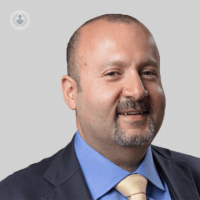Direct anterior approach hip replacement: less pain and faster recovery
Autore:Total hip replacement is an extremely successful surgical procedure that improves a patient’s quality of life, when arthritic hip pain becomes debilitating. Consultant trauma and orthopaedic surgeon, professor Ali Ghoz talks about the new approach to hip replacement surgery that results in:
- quicker recovery
- less postoperative pain
- reduced risk of dislocation
- a shorter stay in hospital and faster return to daily activities
- reduction of scar tissue
- immediate postoperative muscle tone preservation

Hip replacement surgery offers patients the ability to return to their daily activities with improved hip flexibility and movement. Patients with a significant limp as a result of an arthritic hip will often walk normally, following the procedure.
Provided your general health is satisfactory, there is no age limit to replacing the hip joint and timing of the surgery is a quality of life decision.
All patients would like to recover as quickly as possible and with as little pain as possible. New surgical and anaesthetic techniques have improved significantly and these improved techniques have allowed an easier and faster recovery from hip surgery.
We take a look at some advantages of the direct anterior approach to hip replacement and how this new surgical procedure has made hip replacement surgery much easier.
What are the advantages of the anterior approach?
1. Quicker recovery
The minimally invasive direct anterior approach (DAA or AMIS) is an approach that lends itself to a quicker recovery. The surgical approach uses intermuscular planes, allowing exposure of the hip joint without detaching muscle off bone. A patient can recover quicker and return to normal life faster compared to other approaches. Many published articles have confirmed that the anterior approach in the short term, leads to a quicker recovery.
The most common approach to hip surgery, the posterior approach (from the back) requires splitting the gluteus maximus (buttocks) muscle, detaching the external rotator muscles and then reattaching the muscles, along with the capsule. Hence recovery is slower and can be more painful. On the other hand, studies show that there is no major difference in results between a well done anterior surgery and well done posterior surgery, 12 months after the procedure.
2. Shorter hospital stay and faster return to daily activities
There are some short-term hip movement restrictions with the posterior approach (internal rotation of the hip beyond 90 degrees of flexion) for 6-8 weeks after surgery, to prevent hip dislocation while the capsule and muscles recover. Hence returning to daily activities can take more time with this approach and hospital stays are more likely to be longer.
The anterior approach is inherently a very stable approach as there is no muscle repair involved and subsequent movement restriction. Patients can usually return to driving at an earlier stage if they have had an anterior approach surgery.
Are all patients suitable for the anterior approach?
Not all patients may be suitable for the anterior approach due to many factors including:
- Obesity
- Abnormal anatomy
- Severe osteoporosis
- Significant leg length discrepancy
- Deficient bone requiring bone grafting
How to know what approach is best for you:
Professor Ghoz gives every individual a personal assessment, taking into account their hip pathology, the degree of arthritis, day to day function, general health and physique. This assessment helps to determine the best surgical approach for every individual.
The key to a successful hip replacement that should last well over 20-25 years, with the best chance of a good functional outcome and the least chance of complications is to choose an experienced and highly skilled hip surgeon. The British and Australian Joint Replacement Registries and many publications show clear data confirming that more experienced surgeons have better patient outcomes.
While the anterior approach offers a faster recovery, reduced risk of dislocation and reduction of scar tissue, among advantages previously mentioned, we know that it is not suitable for everyone. Professor Ghoz will perform the posterior approach if he believes it to be the better option under certain circumstances. While recovery will be slightly slower, the patient can be guaranteed that within 6-12 months the posterior approach will perform equally as well.
For more information, see Professor Ghoz Top Doctors profile.


